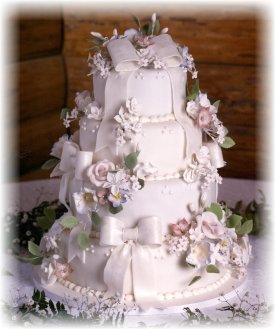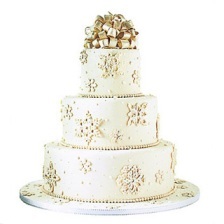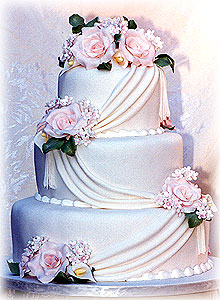Wedding Cake – Customs, Ceremony and Meaning
Interesting Stuff
Wedding cake
A wedding cake is the traditional cake served to the guests at a wedding breakfast, after a wedding. It is usually a large cake, multi-layered or tiered, and heavily decorated with icing, occasionally over a layer of marzipan or fondant, topped with a small statue representing the couple. Other common motifs include doves, gold rings and horseshoes, the latter symbolising good luck.
Nowadays, wedding cakes are very commonly seen in a wedding ceremony, no matter if it’s a western or eastern wedding ceremony. The cake has become a display of individual taste in a modern wedding party – with different shapes and styles and with a rich variety of flavors, fillings, and icing. The bride and the bridegroom will normally cut the first slice out of their all traditional, butter cream frosted, lavish and huge wedding cake reflecting the style, elegance and delicacy of the couple’s upbringing, in addition to their enthusiasm for their marriage.
In early Roman times, the wedding cake was not a huge, tasty and decorative creation, but many small, cupcake-sized, salty wheat cakes. The cakes were not meant for eating but for the guests to throw at the bride or crumbling it over her head for fertility and single women would try to catch the crumbs for the same reason they catch the bridal bouquet today. Fertility was important in the ancient days because many children didn’t make it to adulthood due to childhood illnesses.
In later stage, Romans turned their salty cakes into sweet cakes. This time, they made a slightly larger bridal cake with many smaller cakes surrounding it. The smaller cakes were brought as gifts by the guests. These cakes everyone ate, but still crumbled some over the bride.
After the Roman conquest of the British Isles, Roman customs influenced the natives who baked dry cakes for their weddings and ranked their ale with them. In old England and Ireland, there also was, and still is, the custom of a groom’s cake, dark in color and made of dried fruit.
When the English sent their pioneers into the new world, they also sent their customs with them. The first European settlers in the Americas made fruitcakes for their weddings because their preservation was easier.
The fancy wedding cake with several tiers was created through the initiative of the French, and although scorned by the English at first, it was later adopted and became the norm through all Europe.
The ceremony of cutting wedding cakes has also become another reception by itself. Traditionally, the bride and the groom cut the cake together, the groom placing his right hand over the bride’s right to cut the first slice. Then they feed each other with the first slice while everyone applauds. Sometimes, the top tier is saved for the first anniversary or the birth of the couple’s first child, whichever comes first. In some new world weddings, smearing each other with the icing has been taking hold as a custom, adding hilarity to the reception.

